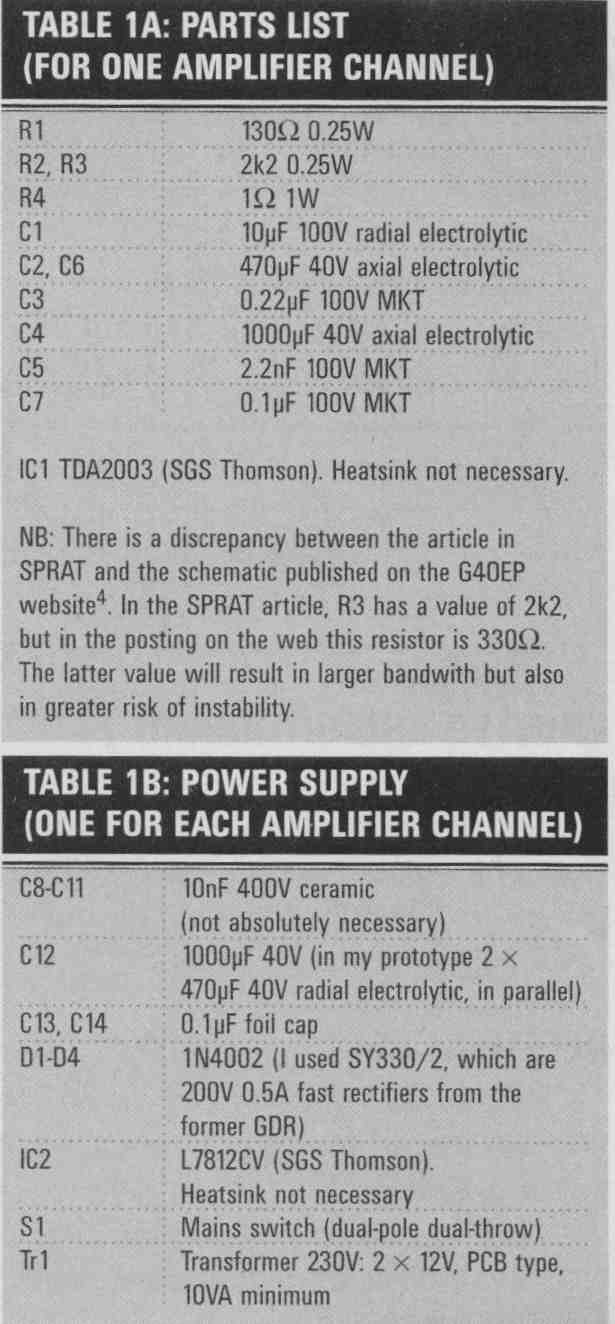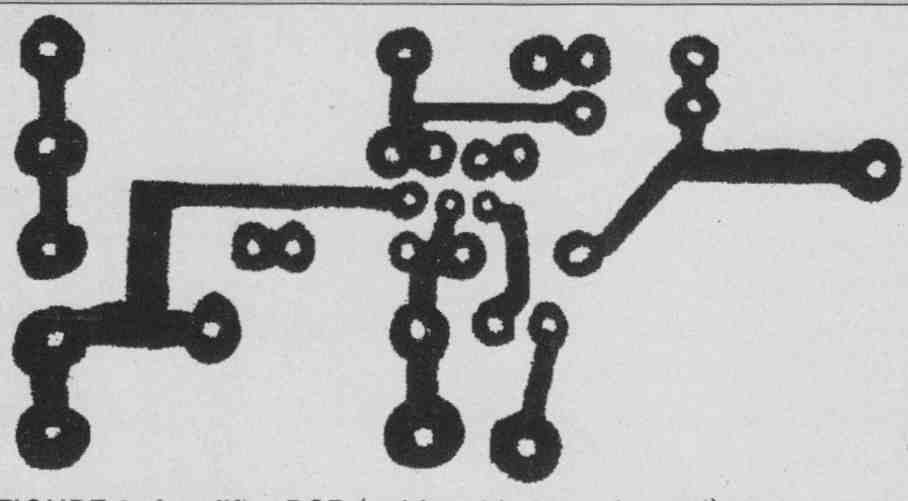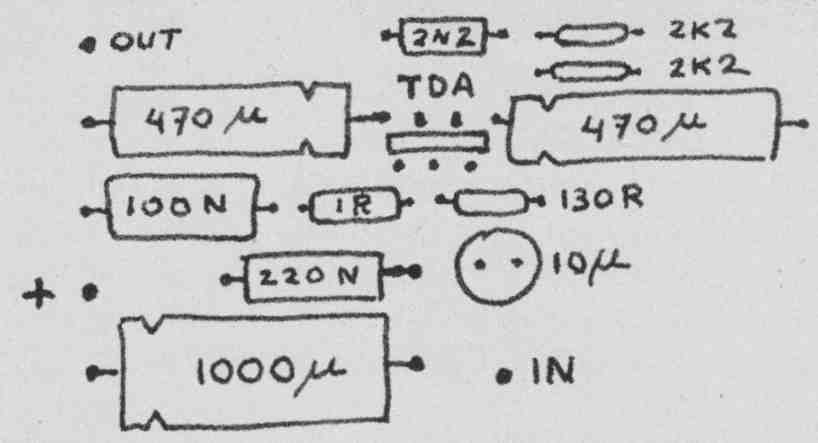|
|
This low-power "chip-amp" design redefines the word ‘simple’.
Would you believe me if I raved about the audiophile qualities of a car audio chip? I cannot blame you if you didn’t. Last spring I constructed a headphone amplifier using a pair of TDA2003 ICs, and this is how it came about.
The UK magazine SPRAT, which, as some of you may know, was an amateur radio quarterly published by the G-QRP club and edited by the Reverend George Dobbs (call sign G3RJV). Its pages are “devoted to low power communication.” Some club members have established radio contacts over a distance of 10,000 miles using intelligent software, very slow Morse code, and just 0.5mW of power! Others have called their ham friends in another city using a lemon as the only power source.
CIRCUIT FEATURES
Occasionally there are more down-to- earth articles in SPRAT. In the summer 2006 issue, Dr. Andrew Smith (call sign G40EP) wrote “High Performance Headphone Amplifier,” which described a circuit based on a well-known car audio chip, the TDA2003 (Fig. 1). This simple circuit comes straight from the datasheet but some component values have been altered in order to reduce the voltage gain (from 100 to 18), and reduce the output power (from 4W to 0.01W).
You can easily reach both goals by in creasing the overall feedback ratio, with the additional benefit of a 25-fold reduction in harmonic distortion. Gain is determined by the ratio of R2 over R1 (Fig. 1). In the standard application, R2 is 220-ohm and R1 is 2.2-ohm, resulting in a voltage gain of about 100. In Dr. Smith’s circuit, R2 is 2k2 and R1 is 130-ohm so that the gain is lowered to (2200 = 18.
High-frequency cutoff (F3) is determined by CS and R2, according to the formula:
F3 = 1/(2 * pi * R2 * C5)
Thus, when C5 = 2.2nF and R2 = 2k2, F3 is set to 33kHz. Low-frequency cutoff is mainly determined by C6 and the impedance of the headphones.

TABLE 1A: PARTS LIST (FOR ONE AMPLIFIER CHANNEL)
NB: There is a discrepancy between the article in SPRAT and the schematic published on the G40EP website In the SPRAT article. 83 has a value of 2k2, but in the posting on the web this resistor is 330-ohm. The latter value will result in larger bandwidth but also in greater risk at instability.
TABLE 1B: POWER SUPPLY (ONE FOR EACH AMPLIFIER CHANNEL)
In my prototype, I measured a -3dB low-frequency cutoff frequency of 13Hz (left channel) and 14Hz (right channel), using a 32 load. When you use head phones with higher impedance (such as the 85I Sennheiser HD25SP of Dr. Smith) the low-frequency cutoff will be shifted to 10Hz (Table 2), and even less in the case of AKG or Beyer dynamic.
According to Dr. Smith, “Objectively the performance of this amplifier is flawless, and it also sounds sweet.” The circuit “gives excellent performance, equal to the very best commercial de signs costing hundreds of pounds I found this hard to believe, because the TDA2003 is a Class B amplifier, and the proposed circuit makes liberal use of negative feedback. Both aspects seem in compatible with good sound. However, I considered the following:
(a) At the small amount of power required by sensitive headphones, the TDA2003 will operate continuously in Class A.
(b) Well-designed op amp circuits with overall negative feedback can sound good, as Dieter Burmester has proven.
(c) My junkbox contains several TDA2003 ICs that I bought in Germany for only 38 Eurocents apiece. For such a small price, you can run the risk and perform some tests! Thus, I decided to give the G40EP circuit a try.
APPLICATION
From experience I know that the TDA2003 chip can be a difficult animal—it is prone to oscillation if the circuit wiring is poorly laid out. The SPRZ4T article warns: “To avoid instability problems, a rigorous single-point earthing scheme should be used. The common earth point should be as close to pin 3 as possible.”
Following this advice, I designed a simple PCB in which R1 and R4 are very close to pin 3. I ensured that the input and output pins of the circuit were at opposite corners of the board, i.e., at a great distance from each other (Figs. 2 and 3). Dimensions of the PCB (3.5 x 2”, or 9 x 5 are based on the use of 40V axial electrolytic capacitors from Philips (HP-LL-M), which, in my opinion, have an excellent price-performance ratio. My parts placement is indicated in Fig. 3.
With this home-made PCB, TDA2003 chips from SGS-Thomson, and the wiring scheme of Photo 1, there is no instability. Each channel of the prototype has its own power sup ply (Fig. 4). The transformer is shared between the channels, but because it has two independent secondaries, the PSU is a dual-mono construction. The supply is very simple and based on L7S12CV voltage regulators.

FIGURE 2: Amplifier PCB (solder side, one channel).

FIGURE 3: Parts placement (one amplifier channel, seen from solder side).
= = = TABLE 2: Amp. Measurements = = =
Voltage gain 18
Nominal power output: 10mW
Maximum output reached at 200mV Input
Harmonic distortion 0.006% (at 1V peak out in 85
Spectrum of distortion (l peak in 85 at 1kHz)
Only 2nd and 3rd harmonic visible
2nd at -90dB
3rd 88dB
Noise 100dB
Hum .84dB (dependent on PSU circuit and layout)
Frequency response. 10Hz — 50kHz (3dB) in 85
(my measurements)
Frequency response 14Hz 300 at 12V
(the 85 ohm load consisted of Sennheiser headphones) (the 32 ohm load consisted of Grado SR125 headphones)
= = = =
LISTENING TESTS
During the listening tests, I was impressed by the audio quality of the following CDs:
1. Tielman Susato, “Dansereye” (1551). New London Consort. Philip Pickett, conductor. Decca 436-131 2 [ Peter Wadland, engineers: Jonathan Stokes and Neil Hutchinson, recorded 1991, released 1998].
A collection of Renaissance dances per formed on a great variety of instruments, including such exotic items as hurdy-gurdy, rebec, cittern, sackbuts, serpent, crumhorn, curtals, shawms, racketts, sordins, rommel pot, and regal. Although originating from the early 16 century (probably even from medieval times), several of these melodies can still be heard in folk music today (listen, e.g., to recordings of the Flemish ensemble Het Kliekske on CBS). My favorites are “Hoboeckendans” (track 16), Pavane La Battaille (i.e., The Fight, track 26), and Entre du Fol (i.e., Entry of the Fool, track 37). The disk is delightful, although occasionally there is some stridence in loud passages, and the performance may be a tad too polished for this repertoire.
2. “Wim van Beek plays the organ of the Dutch Reformed Church in Kantens.” Works of Sweelinck, Scheidt, Van den Kerckhoven, Böhm, Buxtchude, Pachelbel, and anonymous 16 century composers. Orgelcorn missie Kantens, WBK2001 [ released in 2001, engineer: Jan Willem van Willi gen. Can be ordered via the Internet, www. groningenorgelland.nllcd.htm Price 10 Euros].
This is a marvelous CD in every respect, capable of converting even die-hard organ haters. The 17 century organ at the village church of Kantens is a beautiful and unique instrument. The music is joyful, easy on the ear, well played, and very well recorded. Until his retirement, Wirn van Beek was organ teacher at The Royal Conservatory in The Hague and the Conservatory in Groningen.
3. Jacob van Eyck, “Der Fluyten Lusthof” [ Flute’s Garden of Delight]. Played by Erik Bosgraaf on various recorders. With Izhar Elias, baroque guitar, and Inmaculada Munoz Jimenez, pandereta. Brilliant Classics 93391 [ of three CDs released in 2007, engineer: Peter Arts, producer.
Jacob van Eyck (1589-1657), the blind city carilloneur of Utrecht, played his recorder on summer evenings in the Janskerkhof. The public, strolling in the churchyard, was overwhelmed by his virtuosic art. The solo variations, preludes, and fantasias (based on British, French, Italian, Dutch, and Ger man folk songs, besides some melodies from the Geneva psalter) were printed during van Evck’s lifetime in “Der Fluyten Lusthof.” For this recording, Erik Bosgraaf selected 69 of the 150 published works. He plays this music very well, with great freedom of timing and dynamic expression. The CDs are also well-recorded (in a chapel at Warmond, near the city of Leiden). The accompanying booklet is written by Thiemo Wind, who recently defended a doctoral dissertation about van Eyck. For several weeks, this recording occupied the no, 1 position of the Top 50 of classical music releases on Radio Netherlands. Highly recommended!
4. La Bella Noeva: Les Chants de Ia Terre. [ of Giulio Caccini, Alessandro Grandi, Biagio Marini, Claudio Monteverdi, Giovanni Stefani, and an anonymous Italian composer.] Marco Beasley, tenor. Ensemble Accordone. Guido Morini, organ/harpsichord! artistic direction. Alpha 508 [ and re leased in 2003, engineer Hugues Deschaux, see www.alpha-prod.com].
A technically and musically perfect rendering of early 17th century Italian love songs. [ may be biased because I am a great fan of Marco Beasley and his ensemble]. The music is full of emotional expression. ‘La Bella Noeva” means “good news,” and the different love stories are told in a very lively way. The disk finishes with a madrigal based on the biblical Song of Songs, a short version of the Laudate Dominum (setting of Psalm 150), and an alleluia.
5. G.F.Händel, Gloria (World Premiere Recording), Dixit Dominus. Emma Kirkby, soprano, Royal Academy of Music Baroque Orchestra, Laurence Cummings, conductor (Gloria), Hillevi Martinpelto, soprano, Anne Sofie von Otter, alto, Stockholm Bach Choir, Drottningholm Baroque Ensemble, Anders Ohrwall, conductor. BIS CD1235. [ in 2001, engineers Ingo Petry and Robert von Bahr].
In 2001, the manuscript of Fländel’s Gloria was rediscovered in the library of the Royal Academy of Music at London. This CD con tains the world premiere recording of this unknown work, besides an excellent performance of the Dixit Dominus, a Latin setting of Psalm 110. The acoustics of Duke’s Hall at the Royal Academy of Music (Gloria) are rather dry, those of the Adolf Fredrik Church in Stockholm (Dixit Dominus) are more resonant. The voices of soloists and choir are well recorded, with naturally sounding sibilants. And Handel’s music is very beautiful.
6. Friedrich Hartmann Graf, “Out of the Shadow of the Masters.” Sonata in e for flute and basso continuo; trio in D for flute, violin, and cello; quartet in G for flute, violin, viola, and cello; quartet no. 2 in D for two flutes, viola, and cello; quintet in Eb. Ensemble Schönbrunn. Globe GLO 5212 [ producer: Paul Janse, engineer: Paul Peter Polak, recorded in 2004, released in 2005, see www.globerecords.nl].
This disk contains what probably are the first recordings of several unpublished works by F.H. Graf, a contemporary of Joseph Haydn. The manuscripts are in the Gjedde Collection at the Royal Danish Library in Copenhagen. They were “rediscovered” by Martin Root, flute player and leader of the Schonbrunn Ensemble. Graf’s music is surprisingly diverse: some of his works resemble pieces by Johann Christian Bach or Joseph Haydn, the quintet is more in the style of the later chamber music of Schubert. There are many unusual innovations in Graf’s scores, but the outcome is always interesting and pleasing to the ear. The Schönbrunri Ensemble (consisting of eight musicians from Great Britain, Germany, and Holland) plays with great virtuosity and musical perfection, and the recording is excellent. Strongly recommended for anyone who can appreciate music not belonging to the ‘iron repertoire.”
7. F.Mendelssohn-Bartholdv, Paulus (oratorio opus 36). Melanie Diener, soprano, Annette Markert, mezzo-soprano, James Taylor, tenor, Matthias Görne, bass, Choeur de La Chapelle Royale, Collegium Vocale Gent, Orchestre des Champs Elysees, Philippe Herreweghe, conductor. Harmonia Mundi HMC 901584.85 [ CDs] Live recording, Auditorium Stravinsky, Montreux 1995 [ in 1996].
Although this is a live recording, voices sound natural and the strings are very sweet. Mendelssohn’s oratorio (based on the biblical Book of Acts) contains several well-known (Lutheran) hymn melodies. The performances by the four soloists, the double choir, and orchestra are excellent. The album has an informative booklet. Bu% this cheap release if you can, you will not be disappointed.
8. Bach after Bach. Famous works of J.S. Bach transcribed by Max Reger for piano 4-hands (Brandenburg Concertos nos. 2 and 6, Orchestral Suite no.3, Toccata and Fugue in d). Wyneke Jordans and Leo van Doese laar, fortepiano. Challenge Classics CC 72070 [ and released in 1998, producer: Marcel Schopman, engineer: Jorn Mineur].
To most modern listeners, transcriptions of Bach’s music in a late Romantic style are anathema. But any doubts you may have are dispelled after the first few notes. Wyneke Jordans and Leo van Doeselaar (a married couple) play with such joy and vitality, that you must listen to the music. The sound of the Bechstein piano is very well recorded. A truly remarkable production. U
= = = =
FIGURE 4: Power supply (one channel).
For listening, I mainly used a Grado SR125 (32-ohm), occasionally also using a Sennheiser HD465 (60 A Sony Discman and a Marantz CD80 player were the digital audio sources. It turned out that the claims of G40EP are absolutely correct. The amp is very quiet. There is no audible hum and noise during operation. Take care with the orientation of the power trans former: a 900 rotation can make the difference between slight hum and no hum at all.
Switching transients during power-on or power-off are minor. It sounds both sweet and precise. Differences in recording quality or in the acoustics of different recording venues are immediately evident. Percussion instruments and sudden transients are well- reproduced, indicating good control of the headphone by the amplifier. Sibilants are not artificially emphasized, and voices sound very natural when the recording is good (unfortunately, many recordings are rather poor in this respect). In conclusion: I love it and will soon place it in a nice-looking cabinet! This novel design is known as "The G4OEP Headphone Amplifier" after its inventor, but also as "Ii Semplice." This Italian expression means "the simple one." I can't think of a head phone amplifier simpler than this! Semplice is also a musical term, meaning "simple, unaffected, with out embellishments." The musical presentation of the G40EP headphone amplifier is like that: very clean and without any evident flaw.
PHOTO 1: Prototype of amplifier built on a “chassis” made of double-sided PCB material. All signal earth and PSU ground wires run to the headphone jack which serves as a star ground.
PHOTO 2: Amplifier built into metal cabinet.
POST SCRIPT
Since the writing of this article, I have placed the headphone amp with power supply in a spacious metal cab-met which was originally intended to house a computer modem (Photo 2). I added a mains filter to the 230V AC power supply line. Screening of the amplifier by the metal cabinet and the addition of the filter resulted in a small improvement of the sound.
REFERENCES
1. Dr. Andrew Smith, "High Performance Headphone Amplifier," SPRAT 127:27-28,2006.
2. SGS-Thomson, TDA2003: low Car Radio Audio Amplifier. You can download the datasheet for more info.
3. Dieter Burmester is the owner and chief engineer of the company Burmester Audiosysteme, a German manufacturer of high-end audio equipment, based in Berlin (www.burmester.de). Many of his preamp designs use op-amp circuits.
4. SGS-Thomson, L7800 Series Positive Voltage Regulators. You can download the datasheet.
REFERENCES
1. Dr. Andrew Smith, “High Performance Headphone Amplifier,” SPRAT 127:27-28,2006.
2. SGS-Thomson, TDA2003: low Car Radio Audio Amplifier. You can download the datasheet here.
3. Dieter Burmester is the owner and chief engineer of the company Burmester Audiosysteme, a German manufacturer of high-end audio equipment, based in Berlin (www.burmester.de). Many of his preamp designs use op-amp circuits.
4. SGS-Thomson, L7800 Series Positive Voltage Regulators. You can download the datasheet from: here
5. G40EP website: http://g4oep.atspace.com, see especially the page: http://g4oep.atspace.com/ headamp/headamp.htm.
= = = =